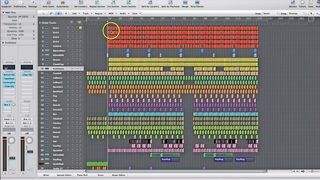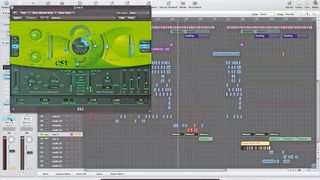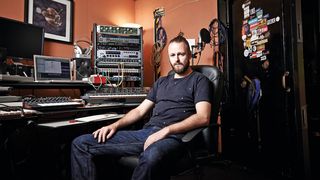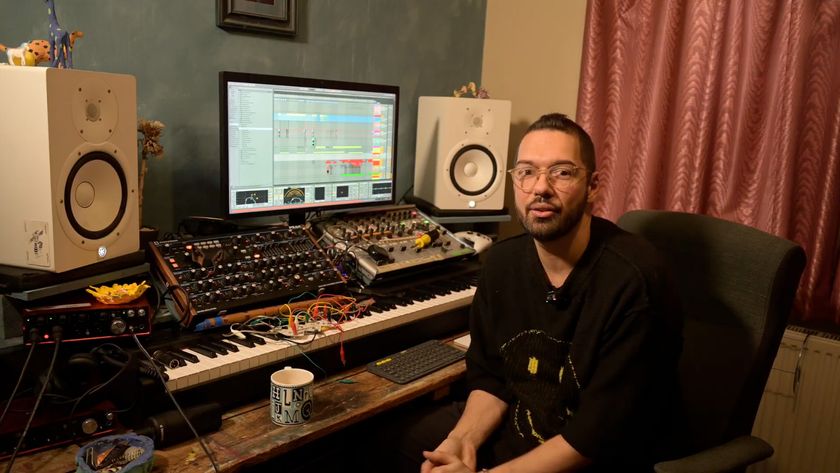The track: Sam Binga on TekNuhChat
The Bristol-based producer breaks down his new release
Bristol-based producer Sam Binga has built a reputation as one of underground dance music's most prolific and successful collaborators. Under his now defunct, Dubstep-leaning Baobinga alias, he released the excellent Joint Ventures LP - an album's worth of collaborative tracks that showcased his uncanny ability to identify and accentuate the best qualities of a broad range of musical sparring partners.
The past couple of years have seen him shift towards working at drum 'n' bass and footwork tempos, but the stylistic shift hasn't diminished his ability to work on killer collaborations, resulting in an impressive string of tracks created alongside the likes of Addison Groove, Om Unit and Fracture.
His latest EP sees him again getting into the studio with vocalist Redders, with whom he created cult hit AYO back in 2013. Ahead of the new EP's release, we headed into the studio with Sam to watch him break down A-side TekNuhChat.
Foundations
"How did this track start? I guess really what it started from was needing a big vocal track for the next EP. I know that sounds quite cynical, but you are trying to put music in a certain world and it's good to have a tune that will fit certain things.
"Myself and Redders have worked together in the past and done some things that have gone down quite well, and I was working on a new EP for Critical, so thought it would be good to have a solid vocal tune. I like working with Redders and I like doing those tunes though, so it's not like it's some sort of horrible, miserable thing that I had to do.
"On a more technical level, what I'll generally do when I'm working with Redders, or working on anything really, is start with a beat. The good thing about working with a vocalist is you can be a bit more minimalist in terms of the music, because you don't want to come out with some incredibly fully-featured track that's got no room for a vocal.
"I'm really into producers like classic Timbaland or The Neptunes where they're doing a huge amount with weird drums but not a lot else. You think about a track like [Clipse's] Grindin' - that's nothing but drums, so I'm trying to bring some of that aesthetic into what I'm doing.
Get the MusicRadar Newsletter
Want all the hottest music and gear news, reviews, deals, features and more, direct to your inbox? Sign up here.

"We're working at 178bpm here, which is a drum 'n' bass speed, but the whole beat is half-step. It's the equivalent of a dubstep feel but at that tempo. I like that because you can mix it with other half-step tunes for a hip-hop feel, or you can layer a full speed drum 'n' bass tune over it and it just gives it a bit of a different groove, which is nice.
"I use a lot of ghost notes to add subtle groove. Ghost notes are when you have an obvious kick and an obvious snare, and then the drummer adds a few little fills in between. I'll try and recreate that feel but without using a snare, so you're getting the groove and the funk that those different placements give you, but with different sounds. So there are all these weirds sounds that, on their own, don't make much sense, but you put them all together in between the main kick and the snare and it all moves in to give it an interesting shape. So you have certain things that anticipate the main kick, or come after the main snare, and the whole thing works together to create an unusual beat with a certain funk to it."
Vocals
"We worked on the vocal together. I think that's important with a vocalist. The more you work with them, the more they get an idea of what you're about, and the more you get an idea of their strengths.
"I knew I wanted to work with Redders from before AYO, as I'd heard some of his stuff with Redlight, and he's got a lot of character in his voice. It almost doesn't matter what he says - he's an amazing lyricist, but we try not to worry about whether the lyrics are making a deep and profound point; it's more that they've got character and interest and are going to catch your ear.
"So he'd come in [once the basic beat is built] and start writing vocals and I'd have been working on the beat as well. While Redders was writing his verse, I put the bassline in too, along with the little bass fill that comes in every 16 bars.
"While I do love synthesis, and I have a few hardware synths here, to my eternal shame that sound is the squarewave from [Logic's] ES1. There's not a lot of distortion on it either. There's a small reverb, but the main thing is that it's heavily sidechained off the kick. It's just a raw sound, but I think, in a world where a lot of people spend a lot of time creating very complex sounds, sometimes something simple can really make you stand out.

"When I play this tune out, when that bassline hits people go nuts, and I'm always surprised by it. I listen to a lot of grime and so much of that is basic sounds done well. There's a lot to be said for taking a simple sound and just going with it."
Layering kicks
"I started off just trying to build a drum track, using five channels of kicks. The first is a top-heavy, distorted one. It's got a Bitcrusher on it, then the bass is cut out of it and the top-end cut down just to add a bit of character.
"Then there's another - which I've excitedly labelled as 'kick 2'. That's a bit more of a punchy one; again, it's really distorted. The third kick is another toppy distorted one, and the next is quite rough-and-ready sounding. It's a lot of kicks but they all add together to give that huge kick sound that you get in a lot of hip-hop. There's a big sub underneath it all, which is what the final kick is, then you've got all this stuff on top adding character.

"You'll notice that with all of these I've just dragged straight into the arrange window; I've not built any samplers out of them. It's a bit of a primitive way of working, but I quite like it as you can really get in and move things around, pull them off the grid to sit early or late. You can see how the whole beat hangs together. I find with MIDI, if you've got multiple channels of different kicks, after a while it can be hard to work out exactly what's lining up. With the audio you can see how the groove is working."
Bass fill
"This is just a square bass again, with a bit of glide and portamento on it. There's a Bitcrusher on it too. Somehow the Bitcrusher gives it a sort of second rhythm - the way it interacts with the bass sound. It's super lo-fi, but it gives it a bit more character. It was a complete accident that - I had no idea it was going to do that."
Distortion
"I like a lot of distortion on my sounds. It's an easy way to add character, and I don't like things that are too clean and crisp. For a lot of people that works really well and in certain genres you need things that are clean, but I want to make stuff that sounds kind of rowdy and almost sounds like the whole thing's been pushed to the edge. So I use lots of distortion. There are loads of amazing plugins you can get for it but I tend to just use [Logic's] Bitcrusher - it just works for me."


Future Music is the number one magazine for today's producers. Packed with technique and technology we'll help you make great new music. All-access artist interviews, in-depth gear reviews, essential production tutorials and much more. Every marvellous monthly edition features reliable reviews of the latest and greatest hardware and software technology and techniques, unparalleled advice, in-depth interviews, sensational free samples and so much more to improve the experience and outcome of your music-making.

“My love letter to a vanished era that shaped not just my career but my identity”: Mark Ronson’s new memoir lifts the lid on his DJing career in '90s New York

“I'm always starting up sessions and not finishing them, but I don't see that as unproductive”: Virtuosic UK producer Djrum talks creativity and making Frekm Pt.2









